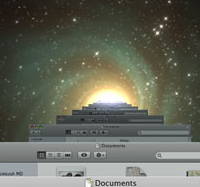User group night: Backup, Leopard and productivity rule

On Monday Sept. 24, I attended the monthly meeting of BMUGWest, a San Francisco group that's been meeting continually for about 18 years (with skips for holidays that fall on meeting dates and the odd closures for major earthquakes). The Mac-centric discussion should make some folks down at Apple headquarters happy and others, perhaps, not-as-happy.

A good number of attendees expressed interest in Leopard's snapshot feature, Time Machine. That will be music to the ears of the Leopard product team. Some of Leopard's goodness is in its plumbing, the features and services that will assist developers and third-party applications; so it's good to see that there are also features that will have an immediate pull for end-users.
At the same time, there was almost no discussion about the new iPods, which were unveiled earlier in the month. I had thought that there would be some mention of the iPod Touch and its capabilities. But no. Backup and recovery were on the minds of users last night.
NAS looks to be a part of the work/content-flow of more users who keep growing their content files. But the level of Mac compatibility by NAS vendors has been spotty, whether in overall data writing performance, support for Apple Filing Protocol, support for large A/V files and support for long file names. Many NAS units on the market target Wintel customers, which can bring complaints from Mac users.
Riding home from the meeting, I wondered whether some users encountering this technology will fully grasp the finer marketing points around capacities and capabilities. Or just the differences between NAS and the JBOD (just a bunch of disks) that they are long used to. The specs may confuse some users.
For example, LaCie a couple of weeks ago announced its LaCie 2big Network (2-disk RAID) the other week. The line targets the entry-level "professional" customer, even though the price tags are more in line with prosumers.
The 1TB model with Gigabit Ethernet, due for release in late November, will cost $399. But that capacity is based on striping its 2 drives with what LaCie calls its Big mode. The capacity of the "Safe" mode, Raid Level 1 mirroring, which will likely be a better solution for more users, cuts that capacity in half. LaCie has higher-capacity versions that will be popular, no doubt.
From the outside these products can look like an external hard drive, and even superficially function as one. But NAS is a much different technology.
Now, LaCie is upfront with everything: from the product specs to its pitch. There's no ding there. And nobody will confuse a "2big Network (2-disk RAID)" with plain hard drive.
I will be interested to see the progress of NAS in the Mac market.
Anyway, here are a few additional notes from demos at the meeting:
Many Mac users own Rogue Amoeba's Audio Hijack Pro for this very purpose (it records sound from any program) but the new software really makes Internet radio recording all very easy. Radioshift can even wake your Mac from deep sleep to record a show. Sweet.
Daylite. We took a tour of Marketcircle's Daylite 3.5 productivity suite, which was released on Friday, Sept. 21. As a longtime user of Now Software's Now Contact and Up-to-Date package, I've never really looked at Daylite. It appeared to be a solid, Cocoa app.
The Version 3.5 update supports Apple’s Sync Services, providing support for handheld devices such as cell phones, the iPhone, iPods, Blackberry and Palm (for the non-Apple devices you will need one of Mark/Space's Missing Sync packages).
The Mac-only software provides integrated modules for contacts, calendars, scheduling and project management. According to the company, the Daylite 3.5 package is aimed at businesses up to 50 users; single-user license is $149.
Yes, I know that the Activity Monitor shows similar data. I also like Brad Gale and Marc Edward's iStat pro widget. Still, the human brain is hardwired for interpreting faces and this little icon can give you a lot of information with just a glance. And it's customizable. And fun.